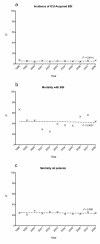Acquired bloodstream infection in the intensive care unit: incidence and attributable mortality
- PMID: 21418635
- PMCID: PMC3219371
- DOI: 10.1186/cc10114
Acquired bloodstream infection in the intensive care unit: incidence and attributable mortality
Abstract
Introduction: To estimate the incidence of intensive care unit (ICU)-acquired bloodstream infection (BSI) and its independent effect on hospital mortality.
Methods: We retrospectively studied acquisition of BSI during admissions of >72 hours to adult ICUs from two university-affiliated hospitals. We obtained demographics, illness severity and co-morbidity data from ICU databases and microbiological diagnoses from departmental electronic records. We assessed survival at hospital discharge or at 90 days if still hospitalized.
Results: We identified 6339 ICU admissions, 330 of which were complicated by BSI (5.2%). Median time to first positive culture was 7 days (IQR 5-12). Overall mortality was 23.5%, 41.2% in patients with BSI and 22.5% in those without. Patients who developed BSI had higher illness severity at ICU admission (median APACHE III score: 79 vs. 68, P < 0.001). After controlling for illness severity and baseline demographics by Cox proportional-hazard model, BSI remained independently associated with risk of death (hazard ratio from diagnosis 2.89; 95% confidence interval 2.41-3.46; P < 0.001). However, only 5% of the deaths in this model could be attributed to acquired-BSI, equivalent to an absolute decrease in survival of 1% of the total population. When analyzed by microbiological classification, Candida, Staphylococcus aureus and gram-negative bacilli infections were independently associated with increased risk of death. In a sub-group analysis intravascular catheter associated BSI remained associated with significant risk of death (hazard ratio 2.64; 95% confidence interval 1.44-4.83; P = 0.002).
Conclusions: ICU-acquired BSI is associated with greater in-hospital mortality, but complicates only 5% of ICU admissions and its absolute effect on population mortality is limited. These findings have implications for the design and interpretation of clinical trials.
Figures





Comment in
-
Impact estimates of nosocomial bloodstream infection: looking from a different angle.Crit Care. 2011;15(3):169. doi: 10.1186/cc10271. Epub 2011 Jun 30. Crit Care. 2011. PMID: 21745423 Free PMC article.
References
Publication types
MeSH terms
LinkOut - more resources
Full Text Sources

